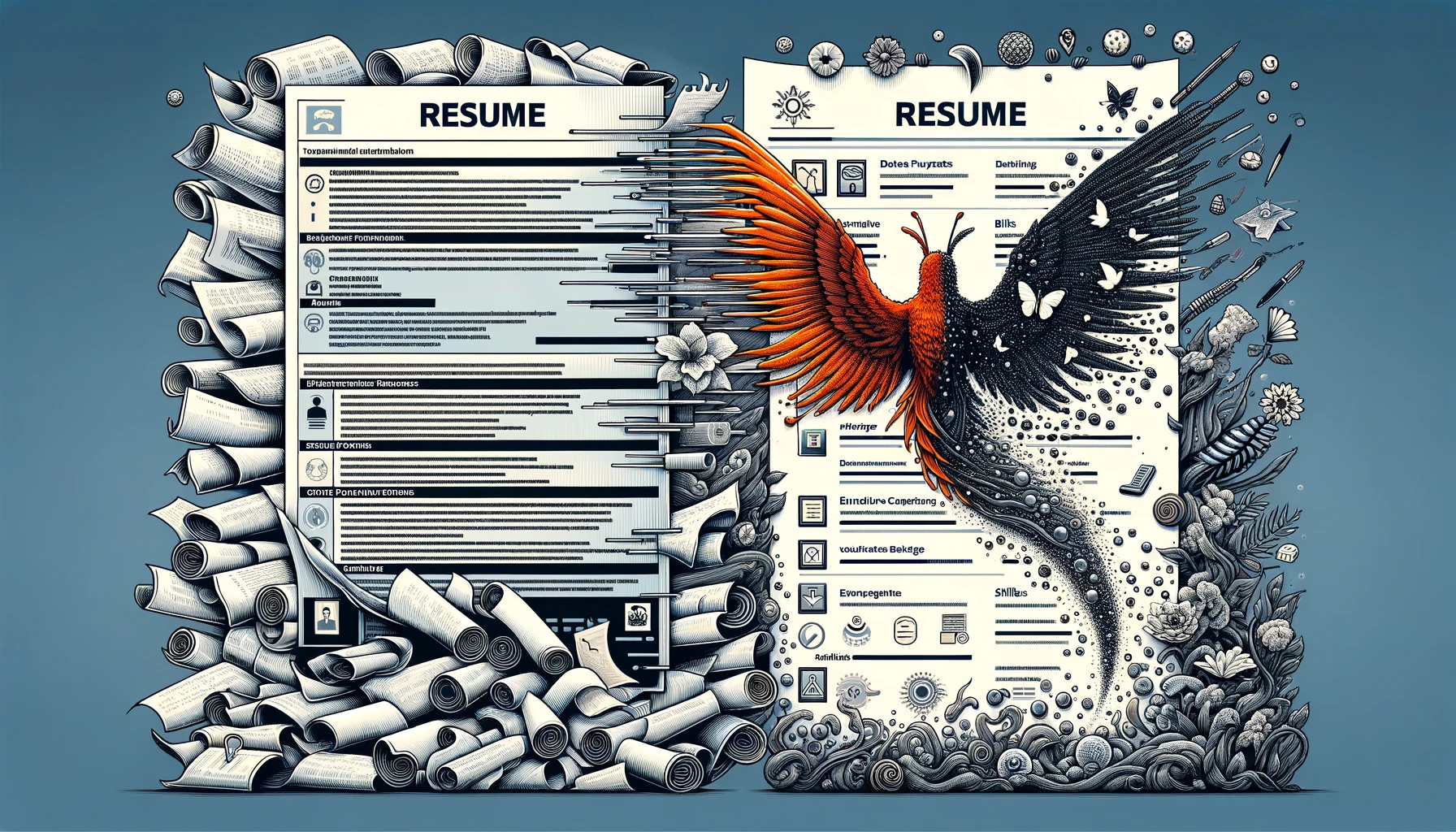In the competitive landscape of job hunting, where first impressions matter more than ever, your resume is your passport to potential career opportunities. Yet, beyond just listing your experiences and skills lies a crucial factor that often determines whether your application lands on the top of the pile or gets lost in the shuffle: the format of your resume. The layout and structure of your resume can speak volumes about you before a single word is read, setting the stage for how recruiters perceive your qualifications and fit for a role.
Imagine crafting a resume like piecing together a puzzle – each piece uniquely designed to highlight different aspects of who you are as a professional. Are you emphasizing steady career progression? Do you want to showcase specific skills relevant to a particular job posting? Or perhaps you aim to shift industries and need to strategically present transferable abilities.
As we delve into this comprehensive guide on crafting the perfect resume through strategic formatting choices, brace yourself for an enlightening journey towards understanding how subtle adjustments can make all the difference in captivating employers’ attention. Let’s unravel the artistry behind presenting yourself effectively on paper and unlocking doors to promising career prospects ahead.
Types of Resume Formats
In the realm of resume crafting, the chronological format stands as a classic choice favored by many. This format showcases your work history in reverse-chronological order, highlighting your progression through various roles. It is ideal for those with a consistent career path or who want to emphasize their upward mobility within specific industries.
The advantage lies in its simplicity and familiarity to recruiters, making it easier for them to track your professional development. However, its rigidity can also be considered a drawback if you have employment gaps or diverse experiences that don’t align neatly.
Enter the functional resume – a strategic maneuver for those looking to shift focus from timelines to skills. By organizing information based on skills and accomplishments rather than job titles and dates, this format caters well to career changers or individuals with non-linear career trajectories. Its strength lies in emphasizing what you can do over where and when you did it, offering flexibility and creativity in presentation.
Yet, critics point out that it may raise questions about your work history or lead recruiters to wonder if you’re hiding something behind skill clusters alone.
Now, blending the best of both worlds comes the combination resume – a hybrid approach seeking harmony between showcasing experience chronology while spotlighting key proficiencies upfront.
This format suits individuals aiming to highlight both their solid work history and standout abilities effectively under one concise document. It works wonders for those with diverse but relevant experiences or achievements across industries who want recruiters to grasp their overall prowess swiftly. Nevertheless, striking the perfect balance between these two elements requires finesse as overlooking either aspect might dilute the impact intended by this amalgamated style.
Crafting Your Targeted Resume
When it comes to job applications, a targeted resume can be your golden ticket to standing out in a sea of applicants. Gone are the days of sending the same generic resume for every position; now, customization is key.
Tailoring your resume for specific job applications involves more than just swapping out a few keywords here and there – it’s about crafting a narrative that aligns perfectly with the role you’re applying for. Think of your targeted resume as a customized pitch to showcase how your skills and experiences directly match what the employer is looking for.
To begin crafting your targeted resume, start by carefully analyzing the job description. Highlight key words and phrases that reflect the qualifications and responsibilities sought by the employer. Use these insights to customize each section of your resume – from the summary statement to the skills section and work experience details.
By mirroring language used in the job posting, you demonstrate not only your understanding of what they’re looking for but also how well-suited you are for the role. Remember, precision is crucial; avoid generic statements or irrelevant details that detract from showcasing your fit for this specific opportunity.
Additionally, consider incorporating a tailored cover letter along with your targeted resume. This personalized touch allows you to further emphasize why you are uniquely qualified for this particular position and company.
Address any specific requirements mentioned in the job description while weaving in examples from your past experiences that directly relate to what they’re seeking. The synergy between your targeted resume and cover letter creates a compelling package that speaks directly to the hiring manager’s needs, increasing your chances of making a memorable impression right from first glance.
Design Elements & Formatting Tips
When it comes to crafting a visually appealing resume, paying attention to design elements and formatting is key. One crucial aspect is selecting the right font styles and sizes that are professional yet easy to read.
Opt for clean and simple fonts like Arial or Times New Roman in sizes 10-12 for body text and slightly larger for headings to create a polished look. Consistency in font choice throughout the resume helps maintain a cohesive visual identity.
In addition to font considerations, how you organize each section can significantly impact the overall readability of your resume. Utilizing bullet points effectively not only breaks up large chunks of text but also highlights key achievements or skills succinctly.
Remember, recruiters often scan resumes quickly, so using bullet points can draw their attention to vital information at a glance. Furthermore, strategically incorporating white space between sections enhances readability and makes your resume easier on the eyes. It provides visual relief and helps ensure your content doesn’t appear cluttered or overwhelming at first glance.
Finalizing Your Perfect Resume
Once you’ve crafted your resume following the ideal format, the final step is to ensure its flawless presentation. Proofreading strategies play a crucial role in this stage. One effective approach is to read your resume out loud — this helps catch any awkward phrasing or errors that might have slipped through earlier reviews.
Additionally, consider asking a trusted friend or mentor to provide feedback. Fresh eyes can often spot typos or inconsistencies that you may have overlooked after spending so much time working on your document.
Beyond traditional proofreading, incorporating Data Quality formulas (DQs) can elevate the accuracy and impact of your resume. Think of DQs as guidelines for maintaining consistency in formatting, spelling, and grammar throughout your document.
For instance, creating a checklist of DQs specific to your industry or job target can help streamline the proofreading process and ensure every detail aligns with professional standards. By implementing these data quality measures into your final review process, you demonstrate meticulous attention to detail and dedication to presenting yourself in the best possible light to prospective employers.
Crafting a Memorable Ending: Mastering the Art of Conclusion
As you near the end of crafting your perfect resume, don’t underestimate the power of a well-crafted conclusion. This final section serves as your last chance to leave a lasting impression on potential employers. Consider it as your parting words, summarizing why you are the ideal candidate for the job and reinforcing key points from earlier sections.
Your conclusion should not simply restate what has already been said but rather elevate it to a higher level. Take this opportunity to showcase your enthusiasm for the position and express confidence in your abilities while thanking the reader for considering your application.
By striking a balance between professionalism and personal touch, you can make sure that recruiters remember you long after they finish reviewing your resume. Remember, an impactful conclusion is not just where you say goodbye; it’s where you make them eager to meet you in person and discuss how you can contribute positively to their organization.
In today’s competitive job market, standing out requires more than just skills—it demands strategic presentation. A compelling conclusion can set you apart from other candidates by displaying personality, passion, and professionalism all at once. Embrace this final opportunity to showcase who you are beyond qualifications—leaving recruiters with no doubt that meeting with you could be their best decision yet.
Unleashing the Power of Chronological Resumes
Chronological resumes, often considered the traditional format, showcase your work history in reverse chronological order, starting with your most recent position. This format is ideal for job seekers with a solid career progression and consistent employment history.
By presenting your experience in a clear timeline, you highlight your growth and development over the years. Recruiters can easily track your professional journey from where you started to where you are now, gaining insights into how well-suited you are for their open position.
One significant advantage of chronological resumes is their simplicity and familiarity to hiring managers. They follow a straightforward structure that makes it easy for recruiters to scan through quickly and understand your career path at a glance. This efficiency can be critical in fast-paced recruitment processes where decision-makers have limited time to review each resume in detail.
Additionally, organizing your experience chronologically allows recruiters to see how recently you’ve been involved in relevant roles or acquired specific skills—a crucial factor when evaluating candidates’ current qualifications for the desired position.





